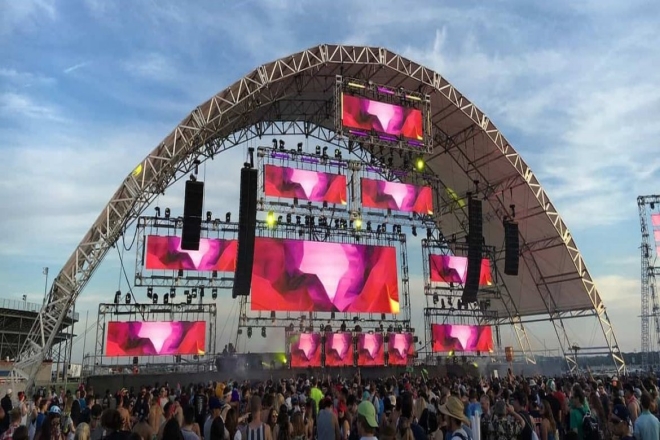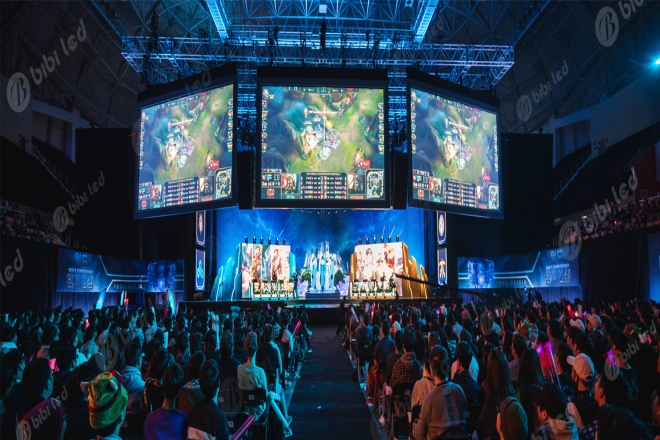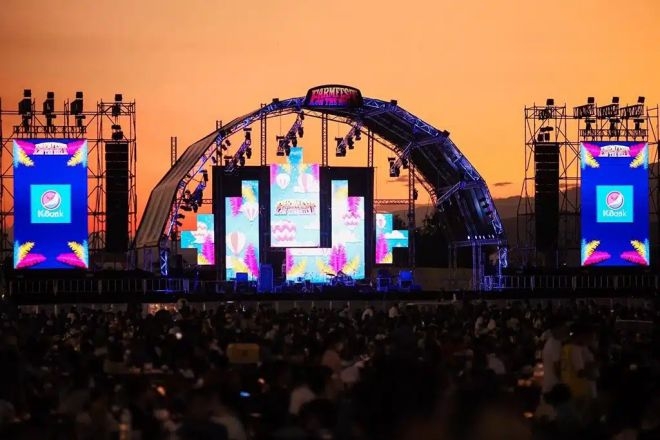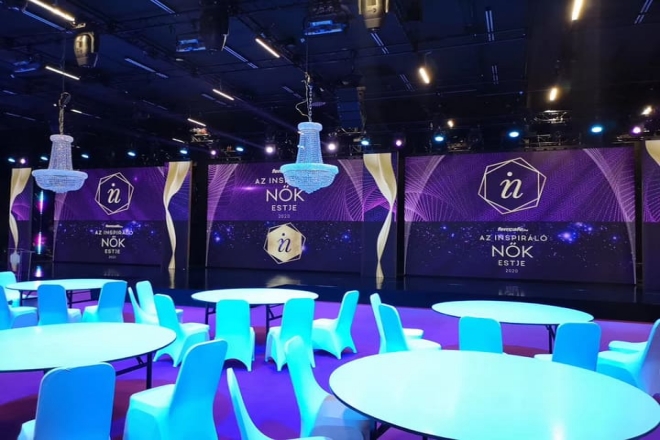介绍

数字时代,信息传递方式正在发生革命,而作为这场革命的先行者,华为的多屏联动技术 LED显示屏 尤为引人注目,它不仅改变了我们展示信息的方式,也增强了观众的视觉体验。
本文将带您一起探索LED显示屏的多屏联动技术如何成为现代视觉显示的中坚力量,以及如何通过无缝整合多种显示界面,创造出震撼的视觉盛宴。
1.多屏联动技术,简单来说
多屏联动就像家里的多个电视或手机屏幕,可以协同播放相同或不同的内容。
在LED显示屏上,该技术可以让多块大屏幕“携手”,共同展现精彩的内容,给观众带来震撼的视觉效果。
试想一下,你在商场里看到的是一块超大的LED屏幕,但其实它是由好几块小屏幕组成的,这些屏幕通过一种“魔法”,可以同步播放广告或者活动画面,就像一块完整的屏幕一样,这就是多屏联动的魅力!
1). 多屏联动技术的实现
- 有线连接:
就像我们用线材连接电视、电脑一样,多屏联动也可以使用专用线材,将多块LED屏幕连接起来。
这种方式比较稳定,就像你在家里用网线把电脑连上网一样,很少掉线。但如果屏幕之间距离较远或者场地不方便布线,就会有些麻烦。
- 无线连接:
就像我们利用Wi-Fi上网一样,多屏联动也可以通过无线网络实现。
此方式无需拉线,十分方便,但如果网络信号不好或屏幕数量过多造成网络拥堵,可能会出现卡顿或延迟。
- 实现方法:
首先确定是有线还是无线连接,然后安装专门的多屏联动软件或系统,这个软件或系统就像一个“指挥官”,可以告诉每个屏幕要显示什么内容。
接下来将准备好的内容(如视频、图片、文字等)上传到系统,最后通过软件的控制,多块屏幕就可以开始联动,为观众呈现精彩的内容。
2.多屏联动三大好处

1).视觉冲击,震撼
想象一下你正在观看一场音乐会,舞台上的大屏幕 阶段 并不是单单一块,而是几块大屏幕连在一起,组成了一幅超级大画面,当歌手在舞台上表演的时候,那种震撼的视觉效果简直让人窒息!
这就是多屏联动带来的视觉冲击力,可以让画面更大,更清晰,让观众仿佛身临其境,感受到更加真实的场景。
2). 信息传输,快如闪电
多屏联动还有一个很实用的好处就是信息传递非常快,比如在新闻发布会上,主持人刚说完一句话,大屏幕上的内容就更新了,这样观众不用等待就能立刻看到最新的信息。
在商场中,如果商家采用多屏联动展示促销信息,顾客可以第一时间了解到折扣活动,增加购买冲动。
3). 无限创意,随心所欲
多屏联动也为创意展示提供了无限可能,设计师可以根据需要将多块屏幕组合成不同的造型和布局,创造出独特的视觉效果。
例如,在 展览, 可通过多屏联动,展示产品的多个角度、多个细节,让观众全方位的了解产品。
或者在婚礼现场,利用多屏联动播放新人甜蜜的照片、视频,营造浪漫温馨的氛围。总之,多屏联动让创意展示更加多样、个性化。
3. 多屏联动的实现技术,通俗的讲
1). 硬件要求
要实现多屏联动,首先要有合适的LED显示屏,就好比拼拼图需要有合适的拼图块,这些显示屏要具备一定的“画质”,也就是分辨率要高,画面才清晰。
亮度也要够,不然太阳底下看不清楚,颜色也要准,不然红色会变成粉色,绿色会变成蓝色,很乱。
此外,这些显示屏必须能够“拼合”,就像拼图碎片必须能够拼合在一起一样。它们之间的边界必须很窄,缝隙必须很小,这样组装起来的大屏幕看起来就像一个整体。
此外,它们必须能够与控制设备“对话”;也就是说,接口必须兼容,并且信号必须能够传输。
当然,还得有个“指挥者”——控制器,来告诉每个显示器要显示什么。这个指挥者必须聪明,处理事情要快,否则屏幕就会卡住或乱七八糟。
2). 软件支持
软件就像是一种向这些显示器和控制器发出命令的“语言”。
首先要有一个软件可以让多个显示器同时显示同一个东西,或者显示不同但相关的东西,这就是多屏同步、分屏显示功能。
那么我们如果想让观众跟屏幕进行互动,比如用手指去改变内容,就必须要有一个软件能够接收这个互动信号,并且告诉屏幕做出相应的反应。
另外,为了方便管理人员远程观看这些显示屏,必须有一个管理系统,这个系统可以让管理人员无论在什么地方都可以看到屏幕的情况,还可以调整画面、更新内容。
而且,为了防止他人擅自改动,这个系统还可以设置不同的权限等级,就像家里的门锁有不同的钥匙一样。
最后,如果这些显示器用于商业用途,例如 购物广场另外,管理系统还可以帮助我们分析哪些内容更有吸引力,哪些时间段观看的人最多,以便我们更好地安排广告。
4. 多屏联动的应用场景,简单来说
1). 商业广告
在商业广告中,多屏联动就像是一个魔术,可以让广告变得超级吸引人。想象一下,你走在商场里,突然看到一整面墙都在播放同一个广告,而且画面很大、很清晰。
你肯定会多看几眼吧?这就是多屏联动的魅力,它可以把多个小屏幕组合成一个大屏幕,让广告看起来更加震撼有趣。而且有些广告可以和你互动,比如触摸屏幕就可以获得优惠券。这样的广告谁不喜欢呢?

2). 文艺演出
在观看演唱会或舞台剧时,多屏联动可以让 阶段 效果更好!比如歌手唱歌的时候,身后的大屏幕就像一个超大版的MV,随着歌曲变换画面,让你有种看电影的感觉。
有时大屏幕上还会显示观众的表情或者互动信息,让演员与观众之间的距离更加近,这样的演出简直就是一场视觉与听觉的盛宴!

3). 会议和 展览
多屏联动在开会或者办展览的时候也很实用,比如开会的时候可以把多个小屏幕组合成一个大屏幕,这样大家就看得更清楚了。
而且如果需要显示多个PPT或者视频素材,多屏联动也可以让它们同时出现在屏幕上,省去了来回切换的麻烦。
展会上,多屏联动可以展示更多的展品信息和公司介绍,让观众更全面的了解展会内容,同时也能提升观众的参观体验,让展会更加有趣、生动。
结论
LED显示屏多屏联动技术以其独特的显示效果和高效的信息传递能力在商业广告、娱乐演出、会议、展览等众多领域展现出巨大的潜力和价值。
随着科技的不断进步与创新,我们可以预见多屏联动技术将在未来的视觉显示中扮演更加重要的角色,为观众带来更加丰富、更加震撼的视觉体验。
让我们拭目以待这项技术将如何继续突破显示技术的界限,创造更多可能。
最后,如果你想了解更多关于LED显示屏的信息, 请与我们联系。
